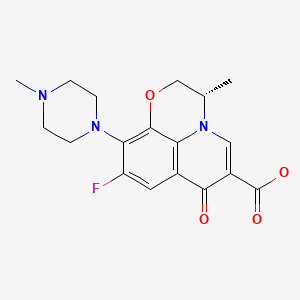Attribution Statement: LactMed is a registered trademark of the U.S. Department of Health and Human Services.
NCBI Bookshelf. A service of the National Library of Medicine, National Institutes of Health.
Drugs and Lactation Database (LactMed®) [Internet]. Bethesda (MD): National Institute of Child Health and Human Development; 2006-.
CASRN: 100986-85-4

Drug Levels and Effects
Summary of Use during Lactation
Levofloxacin is the S-enantiomer of the fluoroquinolone, ofloxacin. No information is available on the clinical use of levofloxacin during breastfeeding. However, amounts in breastmilk appear to be far lower than the infant dose and would not be expected to cause any adverse effects in breastfed infants. Fluoroquinolones such as levofloxacin have traditionally not been used in infants because of concern about adverse effects on the infants' developing joints. However, more recent studies indicate little risk.[1,2] The calcium in milk might prevent absorption of the small amounts of fluoroquinolones in milk,[3] but insufficient data exist to prove or disprove this assertion. Use of levofloxacin is acceptable in nursing mothers with monitoring of the infant for possible effects on the gastrointestinal flora, such as diarrhea or candidiasis (thrush, diaper rash). Avoiding breastfeeding for 4 to 6 hours after a dose should decrease the exposure of the infant to levofloxacin in breastmilk. Maternal use of an eye drop that contains levofloxacin presents negligible risk for the nursing infant.
Drug Levels
Maternal Levels. Ten lactating women (time postpartum not stated) were given the racemic mixture, ofloxacin, 400 mg orally every 12 hours for 3 doses. Milk ofloxacin was measured after the third dose. The highest levels averaging 2.4 mg/L occurred 2 hours after the dose. Average milk levels then fell as follows: 1.9 mg/L at 4 hours; 1.25 mg/L at 6 hours; 0.64 mg/L at 9 hours; 0.29 mg/L at 12 hours; and 0.05 mg/L at 24 hours after the dose.[4] Using the peak milk level data from this study, an exclusively breastfed infant would receive an estimated maximum of 0.36 mg/kg daily with this maternal dosage regimen.
One woman was given levofloxacin 500 mg daily intravenously for 9 days, then orally for 17 days. Twenty-six breastmilk samples were obtained beginning on day 10 of therapy and continued for 6 days after the discontinuation of therapy. A pharmacokinetic model that was developed predicted that a peak milk level of 8.2 mg/L would occur 5 hours after the dose. The milk levels fell with an estimated half-life of 7 hours. Traces of levofloxacin were still detectable in breastmilk 65 hours after the dose. The authors calculated that an exclusively breastfed infant whose mother was taking 500 mg daily would receive 1.25 mg daily in breastmilk, which is far below the dose of levofloxacin used in children.[5]
Two nursing mothers each took one 500 mg capsule of levofloxacin (Tavanic-Sanofi, Istanbul) orally. Eleven complete collections of breastmilk were taken over the following 24 hours. Peak levofloxacin milk levels of 265 and 258 mcg/L occurred at 2.5 and 3 hours, respectively, in the two mothers. Average milk levels were 101 and 105, mcg/L, respectively. The half-lives in milk were 4.95 and 5.33 hours, respectively.[6] Using the average milk levels, a fully breastfed infant would receive an average of 15.5 mcg/kg daily.
Infant Levels. Relevant published information was not found as of the revision date.
Effects in Breastfed Infants
Relevant published information was not found as of the revision date.
Effects on Lactation and Breastmilk
Relevant published information was not found as of the revision date.
Alternate Drugs to Consider
(Systemic) Ciprofloxacin; (Ophthalmic) Ciprofloxacin, Ofloxacin
References
- 1.
- Gürpinar AN, Balkan E, Kiliç N, et al. The effects of a fluoroquinolone on the growth and development of infants. J Int Med Res. 1997;25:302–6. [PubMed: 9364293]
- 2.
- van den Oever HL, Versteegh FG, Thewessen EA, et al. Ciprofloxacin in preterm neonates: Case report and review of the literature. Eur J Pediatr. 1998;157:843–5. [PubMed: 9809826]
- 3.
- Fleiss PM. The effect of maternal medications on breast-feeding infants. J Hum Lact 1992;8:7. Letter. PMID: 1558663. [PubMed: 1558663]
- 4.
- Giamarellou H, Kolokythas E, Petrikkos G, et al. Pharmacokinetics of three newer quinolones in pregnant and lactating women. Am J Med. 1989;87 Suppl 5A:49S–51S. [PubMed: 2589384]
- 5.
- Cahill JB Jr, Bailey EM, Chien S, et al. Levofloxacin secretion in breast milk: A case report. Pharmacotherapy. 2005;25:116–8. [PubMed: 15767227]
- 6.
- Toker SE, Kızılçay GE, Sagirli O. Determination of levofloxacin by HPLC with fluorescence detection in human breast milk. Bioanalysis. 2021;13:1063–70. [PubMed: 34100294]
Substance Identification
Substance Name
Levofloxacin
CAS Registry Number
100986-85-4
Drug Class
Breast Feeding
Anti-Infective Agents
Antibacterial Agents
Quinolones
Fluoroquinolones
Disclaimer: Information presented in this database is not meant as a substitute for professional judgment. You should consult your healthcare provider for breastfeeding advice related to your particular situation. The U.S. government does not warrant or assume any liability or responsibility for the accuracy or completeness of the information on this Site.
- User and Medical Advice Disclaimer
- Drugs and Lactation Database (LactMed) - Record Format
- LactMed - Database Creation and Peer Review Process
- Fact Sheet. Drugs and Lactation Database (LactMed)
- Drugs and Lactation Database (LactMed) - Glossary
- LactMed Selected References
- Drugs and Lactation Database (LactMed) - About Dietary Supplements
- Breastfeeding Links
- PubChem SubstanceRelated PubChem Substances
- PubMedLinks to PubMed
- Review Ofloxacin.[Drugs and Lactation Database (...]Review Ofloxacin.. Drugs and Lactation Database (LactMed®). 2006
- Review Norfloxacin.[Drugs and Lactation Database (...]Review Norfloxacin.. Drugs and Lactation Database (LactMed®). 2006
- Review Ciprofloxacin.[Drugs and Lactation Database (...]Review Ciprofloxacin.. Drugs and Lactation Database (LactMed®). 2006
- Review Gatifloxacin.[Drugs and Lactation Database (...]Review Gatifloxacin.. Drugs and Lactation Database (LactMed®). 2006
- Review Enoxacin.[Drugs and Lactation Database (...]Review Enoxacin.. Drugs and Lactation Database (LactMed®). 2006
- Levofloxacin - Drugs and Lactation Database (LactMed®)Levofloxacin - Drugs and Lactation Database (LactMed®)
Your browsing activity is empty.
Activity recording is turned off.
See more...
